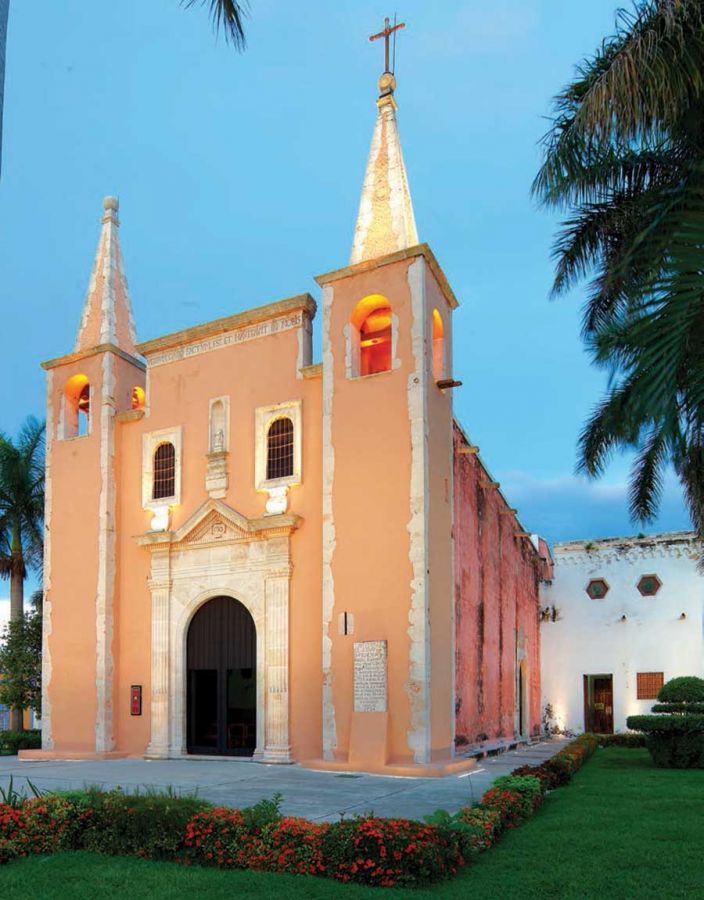…Continues from: THE OLD NEIGHBOURHOODS OF MÉRIDA: SAN CRISTÓBAL
Go to the first article of the series: THE OLD NEIGHBOURHOODS OF MÉRIDA
At the beginning of the 18th century, the “century of the creoles”, the century of urban splendor in many colonial cities, a church was built in the north of the city, consecrated as our Holy Lady Santa Ana, mother of the Virgin Mary.
To link the new church with the Cathedral and the Archbishop’s Palace, both in the main square, a street was planned and embellished to which was given the name “Paseo de Santa Ana”, today known as Calle 60, and which, at the end of the 19th century and beginning of the 20th, was called Calle Progreso, because it was the access road to the great port of Yucatán.
The Paseo de Santa Ana was embellished by eight arches, five of which were found from north to south and the rest from east to west, all of quarry stone, but now demolished. These arches should be restored as soon as possible, to return this street to the splendor it deserves.
The Paseo de Santa Ana offered the city another service: it was used to connect to the road that led to the old settlement of Itzimná, today part of the city, but which at the end of the 19h century was the site selected by the comfortable classes to build their summer homes, before it became the custom to summer in the seaports. The Paseo de Santa Ana replaced the legendary Paseo de las Bonitas, located in Calle 65 in the commercial center of the city; later it was replaced by other avenues, Calle 59, and still later, the Paseo de Montejo. (My note: replaced in the sense that it was the preferred walk for the Sunday strollers).
Certainly the city now had grown far beyond the old Hermitage of Santa Lucía, built in the 16th century. The little square across from it dates from the 17th century; for this reason all the neighboring area offers a definite colonial flavor, particularly the half-point arches that surround the little square and that are so representative of it. In Colonial times, the Hermitage of Santa Lucía was reserved for worship by the mulattos and blacks; the city cemetery was in the atrium of the church, for many years.
In Santa Lucía the celebrated Yucatecan trovedores met at nights, from the first decades of the 20th century; for this reason, every Thursday of the year the legendary serenades take place here, with romantic Yucatecan music.
In the church of Santa Ana there is a plaque that states it was don Antonio de Figueroa y Silva, captain general of the province, who funded the construction of the church and who was one of the few Spanish soldiers to make a successful campaign against the British that occupied Belize, and who by their occupation so insulted His Catholic Majesty, the King of Spain.
The church was built in 1731, that is to say, in the century of urban splendor, the 18th. The Santa Ana Park, after its construction, was famous in the whole city for the orange trees that populated the little square and its immediate surroundings. It was here that the fierce battle between republicans and imperialists took place, the latter being defeated by the efforts of General Manuel Cepeda Peraza, in the fist days of the month of May, 1867.
The park that we know today dates from the end of the 19th century; at the beginning of the 20th century, the then Mayor of the city, don José María Ponce Solís, inaugurated electrical energy service – very different from that that we know today – which extended to the road leading to the settlement of Itzimná, today Calle 60 Norte.
In the suburb of Santa Ana there existed a famous bakery: “Los Catalanes”, that distributed its exquisite product in carts pulled by mules wearing bells on their necks, by which they advertised the presence of the bread.
To this bakery is attributed the invention of the so-called “pan francés”, which is an indispensable part of our daily cuisine. In the last days of the government of General Francisco Cantón, the then mayor of the city, don Alfonso Cámara y Cámara, began work on the construction of the Paseo de Montejo. Finally, in 1906, the statue of don Justo Sierra O’Reilly was unveiled, by which was inaugurated the avenue that carries the name of the Spanish conqueror, an exceptional occurrence in Mexico.
The fiesta of the Santa Ana neighbourhood took place on July 26 of each year with great delight, but it has now vanished, like the other classic fiestas of the city. The Salón Pathé, the Salón Montjeo, and the center “El Tívoli” are legendary places in the sector; in their vicinity was El Maine, which was the zone of tolerance preceding that of Calle 66. Santa Ana preserved its market, which, beautifully restored, still is a point of reference in the city.
Go to next article: THE OLD NEIGHBOURHOODS OF MÉRIDA: SAN JUAN












